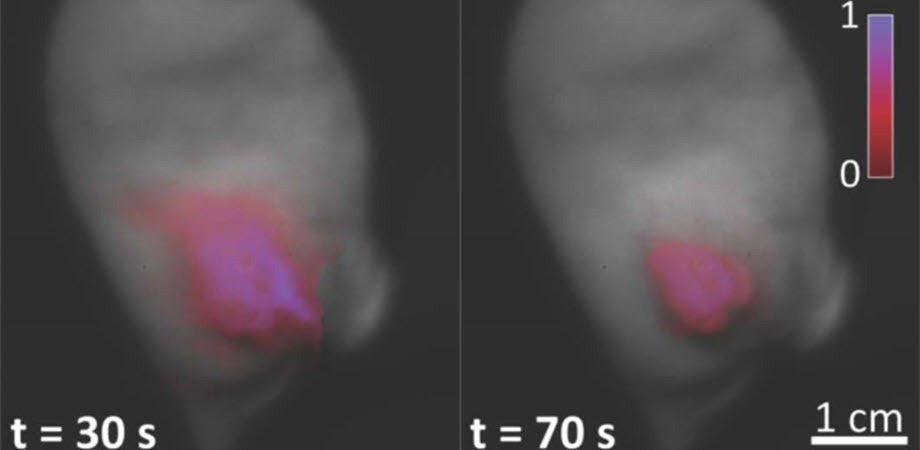It is crucial to distinguish between tumors and healthy tissues during cancer surgery. Fluorescent markers can assist in this process by improving tumor contrast during surgery. Some markers exhibit a phenomenon known as “delayed fluorescence” (DF), which is based on recognizing “hypoxia” (or low oxygen concentration), which is frequently seen in malignancies.
 The signal obtained from cancerous cells was over five times stronger than that from surrounding healthy oxygenated tissues. Cancerous tissue reoxygenates slower than healthy tissue, so palpation prior to imaging amplified the contrast. After 70 seconds, tumor tissue hypoxia on the right is most clearly visible via delayed fluorescence imaging. Image Credit: Petusseau et al.
The signal obtained from cancerous cells was over five times stronger than that from surrounding healthy oxygenated tissues. Cancerous tissue reoxygenates slower than healthy tissue, so palpation prior to imaging amplified the contrast. After 70 seconds, tumor tissue hypoxia on the right is most clearly visible via delayed fluorescence imaging. Image Credit: Petusseau et al.
Real-time hypoxia imaging can reveal a clear distinction between tumors and healthy cells. This can help surgeons remove the tumor more successfully. Unfortunately, real-time hypoxia imaging for surgical guidance is still a work in progress.
Researchers have devised an optical imaging system that allows for real-time imaging of tissue oxygen concentration for tumors that exhibit chronic or transient hypoxia in a recent study that was published in the Journal of Biomedical Optics (JBO). The investigators accomplished this by utilizing an endogenous chemical known as protoporphyrin IX (PpIX), which displays DF in the red to near-infrared spectrum.
This is a truly unique reporter of the local oxygen partial pressure in tissues. PpIX is endogenously synthesized by mitochondria in most tissues, and the particular property of DF emission is directly related to low microenvironmental oxygen concentration. Healthy cells will show little to no DF, because it is quenched in the presence of molecular oxygen.”
Brian Pogue, Chair, Medical Physics, University of Wisconsin-Madison
Brian Pogue is also the Adjunct Professor of Engineering Sciences at Dartmouth College and the senior author of the study.
Due to its low intensity, identifying DF presents a technical barrier; background noise makes detection difficult without a single photon detector. An extremely sensitive time-gated imaging system that only permits signal detection inside a given time window was used by the team to solve this issue.
This significantly lowers the background noise and makes it possible to trace changes in oxygen partial pressure (pO2) directly over a wide field using the collected DF signal. The outcome is real-time metabolic data, a helpful road map for surgical guidance.
Acquiring both prompt and delayed fluorescence in a rapid sequential cycle allowed for imaging oxygen levels in a way that was independent of the PpIX concentration.”
Arthur Petusseau, Study Lead Author and Doctoral Candidate, Engineering Sciences, Dartmouth College
Petusseau’s group established the effectiveness of their strategy by utilizing hypoxic pancreatic cancer mouse models. The DF signal acquired from malignant cells was more than five times greater than that obtained from healthy oxygenated tissues surrounding them. The signal contrast was increased further when the tissues were palpated prior to imaging to augment transient hypoxia.
The results reported by Petusseau’s team suggest hypoxia imaging as an efficient approach to identifying tumors in cancer treatment. PpIX DF detection uses a known clinical dye and an already-approved in-human marker, with great potential for surgical guidance, and more.”
Frédéric Leblond, Professor, Engineering Physics, Polytechnique Montréal
Frédéric Leblond is also an JBO Associate Editor.
According to Petusseau, imaging pO2 in tissues could also allow for control of tissue metabolism. This, in turn, would aid the understanding of the biology of oxygen supply and consumption.
Source:
Journal reference:
Petusseau, A. F., et al. (2022) Protoporphyrin IX delayed fluorescence imaging: a modality for hypoxia-based surgical guidance. Journal of Biomedical Optics. doi.org/10.1117/1.JBO.27.10.106005.